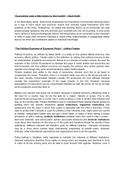Summary
Full Summary of Political Economy readings UvA
- Course
- Institution
- Book
Includes all the required readings for the 2nd year UvA Political Science course Political Economy. the summaries are detailed and consist of article summaries as well as summaries to the chapters of the Schwartz book "States versus Markets".
[Show more]




